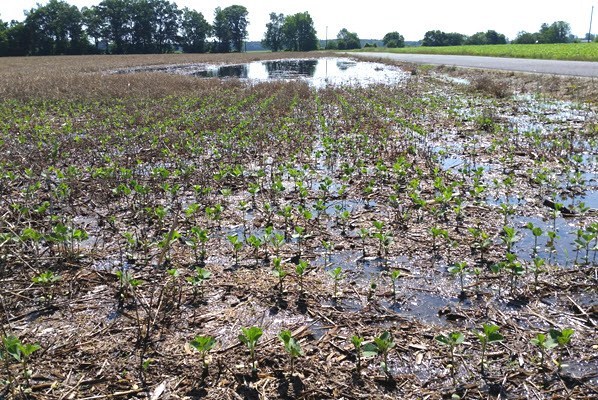St. Louis Landscaping Solutions for Wet and Soggy Ground
If you’re from St. Louis or lived in the area for any length of time, you already know how volatile the local weather can be.
Summers have always been hot and humid, and in 2018 we had record numbers of 90+ degree days. And although daily weather is unpredictable, overall the metro area gets about the same amount of rain (42 inches per year) as the US average (38 in). Because of the heat and moderate precipitation, a popular topic/question from local homeowners is typically how often should I water plants in the summer?
Of course this year has definitely been far from typical so far!
And the records being broken this year aren’t heat-related – but rainfall amounts, so there hasn’t been much need for watering. Saint Louis has already had over 32 inches of precipitation in 2019. The Climate Center at the University of Missouri-Columbia has been keeping weather data for the state going all the way back to 1895. Their reports show that this May (w/ 10.82 inches of rain) was the THIRD wettest month ever recorded in the past 125 years!
The most obvious result of all this extra water is river flooding, but it can create major problems for plants too. Unfortunately, most plants don’t do well with soggy soil, and excess moisture can lead to rot or other plant diseases. This has been especially troublesome for Midwestern farmers, as the nearly constant rain seriously delayed the start of the planting season (or some fields not even being used this year).
By comparison, the problems facing area homeowners don’t have quite the same level of impact. But if you have soggy spots in your yard where water tends to collect and/or drain slowly, this has probably been a frustrating year.
Luckily if you’ve ever experienced this on your property, you have options!
You can either improve the growing conditions, choose plants that like excess moisture, or even find another use for that portion of the yard.
IMPROVE GROWING CONDITIONS
If your wet area is of limited size or in a highly visible area, you might decide to eliminate it rather than trying to accommodate the extra moisture.
Your first choice may be to re-grade the site to allow for water to run-off properly. Though the most intensive choice, if you’re having other work done on your property (and the necessary equipment is available), or if the problem spot is in an otherwise premium location – this could be your solution. For relatively small lawn areas, this could potentially be done by adding soil and using hand tools.
Another option to improve the soil conditions is installing drainage pipe (a French drain) to carry the water away from the area. Though this is less intensive and costly than re-grading, it still requires a significant bit of physical labor to dig the trenches necessary for the pipe. And for either choice, you may need materials like fresh soil, sand and/or gravel to be delivered.
Because of the complexity of these projects – the planning, specialized tools and various materials required to do the job correctly – in addition to the physical labor, they can be difficult for DIY homeowners to tackle on their own. If this isn’t a challenge you are up for, you should call an experienced contractor like our team at Environmental Landscaping.
CHOOSE WATER-LOVING PLANTS
If the wet zone is too large to alter or not well-suited for change (like the banks of a creek), or in a very inconspicuous area – another alternative is to select water-loving plants.
The number of plant specimens which will tolerate or thrive in constantly moist or wet soil is small, limiting your choices. And some of these plants may only be available as special-order varieties, so working with an experienced St. Louis landscaper is the best way to get access to the entire list.
A few perennials that are more commonly available which grow well in these conditions are hydrangea, iris and daylilies. These plants are highly-adaptable and require minimal attention, and provide a bit of color while also serving as general ground cover for the soggy area.
FIND OTHER LANDSCAPING USES
Another potential solution for a soggy patch of ground (or ANY problem area) is to simply re-purpose that section of your property to another use.
This option is obviously highly-dependent on your individual circumstances and personal wants and needs. But the list of alternatives is almost endless – a new patio area, deck, walkway, water feature, recreational area, wet garden or pond (and many more). We have the industry expertise to make your outdoor plans a reality, no matter WHAT you can dream up.
If you have problem areas on your property, we can help! Our experts can assess your unique situation and go over all of your options.
Call Environmental Landscaping at (636) 225-3848, or fill out our quick and easy contact us form.
We look forward to talking with you soon,
Tory Catanzaro
Owner, Environmental Landscaping









